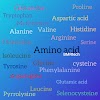Histidine | Structure | Biosynthesis pathway | Functions.....
HISTIDINE AMINO ACID
Or
Histidine is a semi-essential amino acid needed in humans for growth and tissue repair, Histidine is important for maintenance of myelin sheaths that protect nerve cells and is metabolized to the neurotransmitter histamine.
Histamines play many roles in immunity, gastric secretion, and sexual functions. Histidine is also required for blood cell manufacture and protects tissues against damage caused by radiation and heavy metals. Initially thought essential only for infants, it has now been shown in longer-term studies to be essential for adults also. It is encoded by the codons CAU and CAC.
Properties :-
Chemical formula :- C6H9N3O2
Molar mass :- 155.157 g·mol−1
Solubility in water :- 4.19g/100g @ 25 °C
Thermodynamic data :- Phase behaviour (solid–liquid–gas)
STRUCTURE -
HISTORY :-
 |
| Albrecht Kossel |
Histidine was first isolated by German physician Albrecht Kossel and Sven Gustaf Hedin in 1896. It is also a precursor to histamine, a vital inflammatory agent in immune responses. The acyl radical is histidyl.
SYNTHESIS :-
Biosynthesis - The biosynthesis of histidine has been widely studied in prokaryotes such as E. coli. l-Histidine, is an essential amino acid that is not synthesized de novo in humans. Humans and other animals must ingest histidine or histidine-containing proteins. Histidine synthesis in E. coli involves eight gene products (His1, 2, 3, 4, 5, 6, 7, and 8) and it occurs in ten steps. For example, as shown in the pathway, His4 catalyzes 4 different steps in the pathway.
Histidine is synthesized from phosphoribosyl pyrophosphate (PRPP), which is made from ribose-5-phosphate by ribose-phosphate diphosphokinase in the pentose phosphate pathway. The first reaction of histidine biosynthesis is the condensation of PRPP and adenosine triphosphate (ATP) by the enzyme ATP-phosphoribosyl transferase. ATP-phosphoribosyl transferase is indicated by His1 in the image. His4 gene product then hydrolyzes the product of the condensation, phosphoribosyl-ATP, producing phosphoribosyl-AMP (PRAMP), which is an irreversible step. His4 then catalyzes the formation of phosphoribosylformiminoAICAR-phosphate, which is then converted to phosphoribulosylformimino-AICAR-P by the His6 gene product. His7 splits phosphoribulosylformimino-AICAR-P to form d-erythro-imidazole-glycerol-phosphate. After, His3 forms imidazole acetol-phosphate releasing water. His5 then makes l-histidinol-phosphate, which is then hydrolyzed by His2 making histidinol. His4 catalyzes the oxidation of l-histidinol to form l-histidinal, an amino aldehyde. In the last step, l-histidinal is converted to l-histidine.
SUBSCRIBE FOR MORE INFORMATION........!







0 Comments